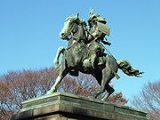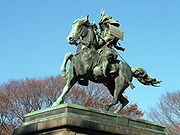
Kusunoki Masashige
Encyclopedia

Samurai
is the term for the military nobility of pre-industrial Japan. According to translator William Scott Wilson: "In Chinese, the character 侍 was originally a verb meaning to wait upon or accompany a person in the upper ranks of society, and this is also true of the original term in Japanese, saburau...
who fought for Emperor Go-Daigo
Emperor Go-Daigo
Emperor Go-Daigo was the 96th emperor of Japan, according to the traditional order of succession....
in his attempt to wrest rulership of Japan
Japan
Japan is an island nation in East Asia. Located in the Pacific Ocean, it lies to the east of the Sea of Japan, China, North Korea, South Korea and Russia, stretching from the Sea of Okhotsk in the north to the East China Sea and Taiwan in the south...
away from the Kamakura shogunate
Kamakura shogunate
The Kamakura shogunate was a military dictatorship in Japan headed by the shoguns from 1185 to 1333. It was based in Kamakura. The Kamakura period draws its name from the capital of the shogunate...
and is remembered as the ideal of samurai loyalty
Bushido
, meaning "Way of the Warrior-Knight", is a Japanese word which is used to describe a uniquely Japanese code of conduct and a way of the samurai life, loosely analogous to the concept of chivalry. It originates from the samurai moral code and stresses frugality, loyalty, martial arts mastery, and...
.
Tactician
A brilliant tactician and strategist, Kusunoki's cunning defense of two key Loyalist fortresses at AkasakaChihayaakasaka, Osaka
is a village located in Minamikawachi District, Osaka, Japan.As of 2009, the village has an estimated population of 6,131 and a population density of 164 persons per km². The total area is 37.38 km²....
and Chihaya
Chihayaakasaka, Osaka
is a village located in Minamikawachi District, Osaka, Japan.As of 2009, the village has an estimated population of 6,131 and a population density of 164 persons per km². The total area is 37.38 km²....
helped allow Go-Daigo to briefly return to power. However, one of the loyalist generals, Ashikaga Takauji
Ashikaga Takauji
was the founder and first shogun of the Ashikaga shogunate. His rule began in 1338, beginning the Muromachi period of Japan, and ended with his death in 1358...
, betrayed Go-Daigo and led an army against Kusunoki and the remaining loyalists. Kusunoki suggested to the Emperor that they take refuge on sacred Mount Hiei
Mount Hiei
is a mountain to the northeast of Kyoto, lying on the border between the Kyoto and Shiga prefectures, Japan.The temple of Enryaku-ji, the first outpost of the Japanese Tiantai sect of Buddhism, was founded atop Mount Hiei by Saichō in 788. Both Nichiren and Honen studied at the temple before...
and allow Takauji to take Kyoto
Kyoto
is a city in the central part of the island of Honshū, Japan. It has a population close to 1.5 million. Formerly the imperial capital of Japan, it is now the capital of Kyoto Prefecture, as well as a major part of the Osaka-Kobe-Kyoto metropolitan area.-History:...
, only to swoop down from the mountain, and with the help of the monks of Mount Hiei, trap Takauji in the city and destroy him.
Disaster
Go-Daigo was unwilling to leave the capital however, and insisted that Kusunoki meet Takauji's superior forces in the field in a pitched battle. Kusunoki, in what would later be viewed as the ultimate act of samurai loyalty, obediently accepted his Emperor's foolish command, left his death poem with his young son Masatsura and knowingly marched his army into almost certain death. The battle, which took place at MinatogawaBattle of Minatogawa
The Battle of Minatogawa also known as the Battle of Minato River was fought in 1336 between Japanese forces loyal to Emperor Go-Daigo and the Ashikaga clan. The Imperial forces were led by Kusunoki Masashige and Nitta Yoshisada, while the Ashikaga were led by Ashikaga Takauji. The Ashikaga were...
in modern-day Chūō-ku
Chuo-ku, Kobe
is one of 9 wards of Kobe City in Japan. It has an area of 28.37 km², and a population of 119,768 .The Consulate-General of Panama in Kobe is located on the eighth floor of the Moriyama Building in Chūō-ku.-Related matters:*Port of Kobe*Port Island...
, Kobe, was a tactical disaster. Kusunoki, his army completely surrounded, down to only 73 of the original 700 horsemen, committed suicide along with his brother Masasue, 11 close clan members, and 60 others. According to legend, his brother's last words were Shichisei Hōkoku! (七生報國; "Would that I had seven lives to give for my country!") and Kusunoki Masashige agreed. There are two accounts of arguments that Kusunoki Masashige made to emperor Go-Daigo. One was that they regroup and attack from two sides, the other was that they bring back general Takauji to their side thus balancing the scales. Both arguments were ignored.
Legacy
His son, Masatsura, served the emperor's successor, the 12-year-old Go-Murukami, in a relationship of reciprocal trust and devotion mirroring the figure of his father Kusunoki and keeping the flame of loyalist resistance alive. Masatsura died alongside his brother Masatoki and cousin Wada Takahide in a battle that saw the end of the Kusunoki clan and there followed a less-than-ideal scramble for power and gain among the Courts.Kusunoki Masashige's successful defense of Chihaya castle is believed to have helped turn the tide against the Kamakura bakufu/shogunate (military rule and the first shogunate). Partly because he held out so long in his castle, Ashikaga Takauji revolted and came to the aid of the emperor, and thus ended the Kamakura bakufu. However, Ashikaga Takauji quickly learned that he did not like following the emperor's commands, and revolted again to establish his own Ashikaga bakufu (the second, middle shogunate). He was able to establish his own shogunate after defeating Kusunoki Masashige and the commander in chief Yoshisada in the final battle. Kusunoki Masashige tried to intervene and bring Ashikaga Takauji back to the emperor's side, but the emperor rejected this plan.
Legend
After the full-scale introduction of Neo-ConfucianismNeo-Confucianism
Neo-Confucianism is an ethical and metaphysical Chinese philosophy influenced by Confucianism, that was primarily developed during the Song Dynasty and Ming Dynasty, but which can be traced back to Han Yu and Li Ao in the Tang Dynasty....
as a state philosophy by the Tokugawa Shogunate
Tokugawa shogunate
The Tokugawa shogunate, also known as the and the , was a feudal regime of Japan established by Tokugawa Ieyasu and ruled by the shoguns of the Tokugawa family. This period is known as the Edo period and gets its name from the capital city, Edo, which is now called Tokyo, after the name was...
, Kusunoki Masashige, once-called a traitor by the Northern Court, was resurrected with Emperor Go-Daigo as a precursor of Sinocentric absolutists, based upon the Neo-Confucian theories. During the Edo period
Edo period
The , or , is a division of Japanese history which was ruled by the shoguns of the Tokugawa family, running from 1603 to 1868. The political entity of this period was the Tokugawa shogunate....
, scholars and samurai who were influenced by the Neo-Confucian theories created the legend of Kusunoki and enshrined him as a patriotic hero, called Nankō (楠公) or Dai-Nankō (大楠公), who epitomized loyalty, courage, and devotion to the Emperor. Kusunoki later became a patron saint of sorts to the World War II
World War II
World War II, or the Second World War , was a global conflict lasting from 1939 to 1945, involving most of the world's nations—including all of the great powers—eventually forming two opposing military alliances: the Allies and the Axis...
kamikaze
Kamikaze
The were suicide attacks by military aviators from the Empire of Japan against Allied naval vessels in the closing stages of the Pacific campaign of World War II, designed to destroy as many warships as possible....
, who saw themselves as his spiritual heirs in sacrificing their lives for the Emperor.

